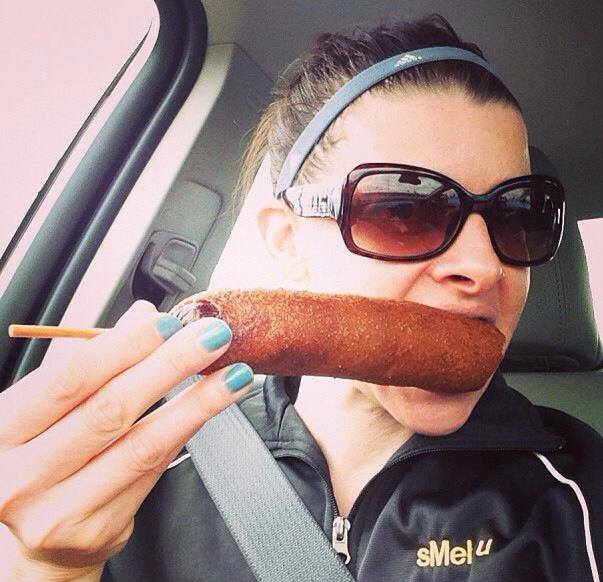Welcome to Weird Wednesday – where I highlight the awesomely weird in the weird world of sports!

I have become obsessed with learning more about the sport of competitive eating, thanks to the book “Raw Dog” which introduces readers to the awe of the sport (alongside a written travel journey/history of the hot dog).
Are you ready to embark on a journey to the world of sports where hunger is the ultimate adversary, and gluttony is the name of the game? Welcome to the weird universe of competitive food eating! 🌭🏆
No Guts No Glory
In the realm of sports, competitive food eating stands as a stomach-churning anomaly (admittedly, it’s *really* hard to watch videos of people eating). I wondered: what drives competitive eaters to push the boundaries of gastronomic endurance?
Joey Chestnut, a legend in this field, devoured 76 (SEVENTY-SIX!) hot dogs in 10 minutes. It’s got to be more than just really liking to eat, right?
Competitive eaters often take on a diverse range of food challenges to showcase their eating skills. While specific events and challenges can vary, some of the foods and challenges competitive eaters have tackled may include: Hamburgers, pizza, wings, tacos, ice cream, spicy foods (featuring extremely spicy foods, such as hot peppers, hot sauces, or curries), pasta, and desserts.
There is also a professional league that oversees many of the aforementioned food showcases: Major League Eating. Pick your fighter eater.
More Than Just a Stomach
Competitive food eating is a sport that defies conventional expectations.
Michelle Lesco, hot dogs, gyoza, rib meat: “Competitive eating is a mental game. You have to stay focused, block out distractions, and stay true to your strategy.”
Beyond the apparent spectacle of devouring massive quantities of food, it delves into the realms of discipline, strategy, and athletic preparation. Competitive eaters are not merely eating enthusiasts; they are dedicated athletes. They engage in intensive training routines, which include refining their technique, mastering the art of portion control, and undertaking jaw-strengthening exercises. Yet, it’s not just physical prowess that sets them apart; it’s their mental fortitude. These athletes enter each competition with a game plan, meticulously calculating the optimal approach to conquer their opponents. They cultivate the mental abilities to navigate discomfort and fatigue, thereby turning what may appear as an indulgent pursuit into a well-balanced fusion of physical strength and mental fortitude. Competitive food eating is a multifaceted sport that demands much more than a stomach—it demands dedication, preparation, and an unwavering appetite for victory.
The Digestion Dilemma
Of course, all that eating comes with a price. Competitive eaters often face the aftermath of their epic feasts with a mix of satisfaction and digestive distress.
Hot Wings competitor, anonymous: “It’s a battle on both ends… You’ve got to have a strong stomach and nerves of steel. Let’s just say, my bathroom knows me pretty well after a competition.”
(My reader, I am sorry.)
In the competitive food-eating arena, triumph is often followed by the less glamorous side of the sport—the digestion dilemma. Consuming massive quantities of food in a short span can challenge even the most robust stomachs. Competitors must carefully manage post-competition discomfort and, occasionally, digestive distress. It’s a reminder that beyond the spectacle, these athletes endure physical strains and face genuine health concerns. Competitive food eaters diligently work to strike a balance between their passion for the sport and the well-being of their bodies, making it a sport that demands not only mental fortitude but also responsible self-care.
The Heart, Mind & Stomach of a Champion
In the world of competitive food eating, champions are crowned based on their ability to consume colossal amounts of food in record time. But beyond the sheer gluttony, there’s a camaraderie among competitors and a sense of pushing the limits that binds them together.
Whether you’re an aspiring competitive eater or just a curious spectator, competitive eating can be physically demanding and mentally taxing. Train your mind to recognize discomfort and fatigue by setting mental resilience goals during practice sessions.
“The sport of competitive eating is as much, if not more, mental, as it is physical” – the “Black Widow” of Competitive Eating, Sonya Thomas.
Sonya points to nervousness or lack of focus as potential impacts on her performance, particularly when she needs to be attuned to the “speed of swallow.” Here are a few tips to address the specific mental challenges and strategies relevant to competitive food eating, that might help YOU excel in this unconventional sport:
- Visualize Your Eating Strategy: Prior to a competition, visualize yourself at the table, strategically tackling the food challenge. Imagine your technique, the rhythm of your bites, and how you’ll pace yourself throughout the event.
- Stay Present with Each Bite: Focus on the present during competition. Concentrate on the taste, texture, and swallowing process of each bite you take. By staying mindful of the food, you can maintain control of your pace. Regularly practice mindful eating!
- Focus on the Process: Instead of fixating on the final outcome or the sheer volume of food you need to consume, concentrate on the process of eating. Break the challenge down into smaller, manageable portions, and stay focused on one bite at a time. This can prevent feelings of overwhelm and anxiety.
- Adapt to Changing Conditions: Competitive eating can vary in terms of food type, portion size, and competition rules. And then there’s the potential for digestion issues. 🥴 Have a flexible mindset that allows you to adjust your strategy as needed during the event.
Who knew that a sport involving hotdogs and pies could leave us all so hungry for more? 🌭🥧😂
Competitive food-eating competitions are a spectacle like no other. Whether it’s the iconic Nathan’s Hot Dog Eating Contest on the Fourth of July or a local chili challenge, crowds are hungry for entertainment and incredible eating displays.